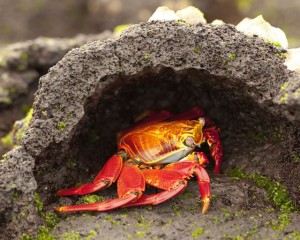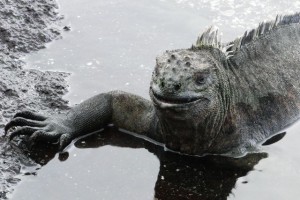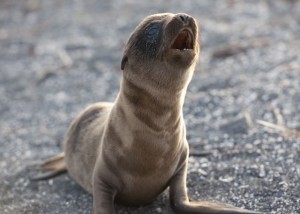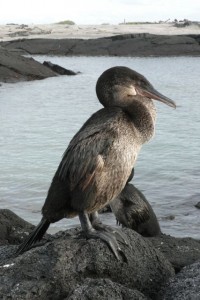For us, it all nearly ended at the equator. When I say “at” the equator, I mean The Equator in all its geographic and nautical senses, that line that cuts the earth in two, like a halved grapefruit.
But first, a bit about the Galapagos. I’m going to limit myself here, in part because it’s hard to know where to begin. And also because I’m afraid once I start, I won’t be able to stop. I will admit, at the risk of provoking all sorts of rolling eyeballs and gasps about the sacreligiousness of such thoughts, that I didn’t expect much from the Galapagos. I wanted to come here, because I knew intellectually the Galapagos needed to be seen. But I didn’t think it’d be my kind of place.
Here’s why. I don’t go in much for plants, insects, LBJs–little brown jobs, a name given to that general class of birds that are so similar one to the other, such as sparrows, or, dare I say it, Darwin finches, that only an experienced birder could tell them apart, or want to. And I’m not an experienced birder. I know that the smaller inhabitants of the earth have an essential place in the ecosystem. But, honestly, they strike me as existing to provide lunch for the big ones that are my favorites. I’ll take a lion over a lava lizard any day. What I find appealing are things with fur, things that lumber, run or flap away when I approach, things that are large or in other ways impressive.
Having confessed this, I can now say that I have been struck dumb by what I’ve seen and experienced here. It is without comparison anywhere in the world. Take, for example, our first day, on the island of Genovesa which is in the northern part of the Galapagos. A zodiac transported us from the ship to the sheer black lava cliffs of the island, where we clambered up a narrow couloir of slippery steps. Around our feet scurried brilliant red sally lightfoot crabs, going about their crustacean business like small bursts of flame.
Emerging on a shrub-covered plateau, we found ourselves surrounded by red-footed boobies and magnificent frigate birds. They weren’t wheeling about in the sky and they didn’t take flight in alarm. Just the opposite. Not one of them flew away. Nor did they come over to beg. Whatever they were doing, whether napping, feeding, preening, courting, they continued doing, as if we weren’t even there. We walked within inches of boobies, which are about the size of your typical seagull, but infinitely more engaging. They ignored us, making it clear we were irrelevant to them. Even a nesting mother with a one week old chick was unconcerned with our presence. I was overwhelmed with a feeling of harmony, of rightness, that this was the way the world should be.
After lunch that day, we went snorkeling along those same cliffs, in an area where earlier we’d noticed some sea lions resting above the water. We flippered over to them and I did my best barking sea lion imitation. One of them bestirred herself from her nap, sliding into the water to investigate us. So, there we were, floating on the quiet, deep blue swells, while the sea lion twirled and dove around us, at times hanging upside down, then with a swish righting herself and rolling on her back. She even came over and gave me the once over with her large round puppy eyes. It’s a good thing I kept my snorkel firmly in my mouth or I’d have swallowed more than one gulp of sea water in astonishment. And, you know, you’re not supposed to take anything away from this area….. so that would have been bad form.
In the past few days I’ve drifted with giant green sea turtles, startled white-tipped reef sharks, hovered silently above giant manta and spotted eagle rays, watched flightless cormorants chase fish through crystalline green waters, dashed about with Galapagos penguins. These latter, by the way, are only 10 inches tall, the tiniest, most efficient packages of fish predation I’ve seen. On land there isn’t the great variety of life you see in Africa. Anything on the islands had to drift there on vegetation rafts, so things (like amphibians) that couldn’t survive for a couple of weeks without water didn’t make it. Island life is limited to reptiles, such as lizards and iguanas, the latter found in both land and marine form. Let me just say that seeing a pile of 50 marine iguanas, with their salt-crusted crests and grey-black bodies all twisted and coiled on top and around each other, is the stuff of bad science fiction. These creatures aren’t actually very big, their bodies perhaps a foot long and the tail the same. But they’re prehistoric-looking. Plus, they spit. A clump of marine iguanas is a creepy sight.
Give me a sea lion pup any day. These little ones, some just a couple weeks old, sun themselves while their mothers hunt, and are always willing to test whether one of us might be that mother, now returned with fish, by emitting a bleat that sounds exactly like a lamb.
Which brings me now to the late afternoon when we sailed forth from Isabela island en route to Bartolome, which is where Master and Commander was filmed. After an unplanned detour to chase a pod of common dolphins, the captain informed us we’d soon be crossing the equator, an occasion which called for celebratory cocktails and the traditional jump from the bridge into the ocean. A half hour later, when the captain called us all forth with several great blasts of the horn, Bernard, who doesn’t usually go for such things, appeared in his swim suit, prepared to jump. Not to be outdone, I dashed to our cabin and put on my suit. When at sea one must do as the mariners do. And what could be better than jumping onto the equator? Though it should have been a warning that not one mariner appeared in his swim trunks.
There we were on the bridge and as the captain slowed the ship and prepared to cut the engines, I made the mistake of looking down. “Oh, that’s not so far down,” I told myself. “I can do this. All I need to do is climb on the railing and step off.” But then, as it took the captain longer to stop the boat, I had time to think about just how far it was from up here on the bridge, to down there in the water. And the longer I thought about it, the farther it became. Until there was no way I was going to go over that railing on the top deck. But I was in my bathing suit, and I had to go somewhere. So I ran downstair to the lower deck, which seemed a less deadly height above the ocean. Bernard stayed above, and another gentleman joined me below.
We each clambered to a perch on our respective bits of railing, waiting for the captain to call the spot. When he did, Bernard jumped first. As soon as I saw him go by, I jumped. The gentleman next to me, with his barrel of a belly and cheery pink dimpled face, jumped third, by which time the boat had drifted maybe 20 feet. I surfaced to a froth of water, and didn’t see any other faces around me. Where were they? A few seconds later, up popped Mr. Barrel Belly. We were both giddy and congratulatory, until on looking around, we realized that Bernard still hadn’t surfaced. Uh oh. A long few seconds after that, and finally Bernard popped up, looking stunned and puzzled. Barrel Belly immediately started apologizing. “Oh dear!” he said. Being British he could say something inconsequential like that, yet sound truly sorry. “Was that you underneath me?” And then he added, “No wonder it seemed rather shallow here!” As we were in the middle of the Pacific, there really was no response I could give to such a statement.
Perhaps you’re starting to get the picture? Large man plummeting down through the water, Bernard right below him kicking his way up to the surface… Thanks to the drift of the ship and the unplanned timing of our jumps, Barrel Belly had landed right smack on Bernard’s head. Thank goodness the water was, well, liquid, so that when Bernard was hit with the force of a pile driver he easily sank back down into the depths, rather than having to absorb the full brunt of Barrel Belly’s 250 pounds with his neck. What began as a lark, in an instant could have turned to calamity. Bernard, thankfully, was spluttering and laughing, trying not to rub his head and neck too noticeably. It all ended fine, with Bernard being barely an inch shorter than when we boarded the ship.
As for me, I made it a point to jump off the high deck the next day–25 feet up if you’re counting Which I am. There wasn’t any equator around, and this time the ship was at anchor. Still, I made sure no one would jump off after me. I did it to prove to myself I could. And then I did it again, just because it was fun.
There is so much more to the Galapagos than I will share here. Must leave something to talk about when I get home. Meantime, do get a book if you’re interested in knowing more. Suggestions are Beak of the Finch by Jonathan Wiener, and Charles and Emma: The Darwins’ Leap of Faith by Deborah Heiligman.
My first hours back on land today I was hit with landsickness, as my tortured inner ear, which somehow had agreed to stay stable for 7 days at sea, couldn’t take the change from rolling to stationary. I got dizzy and queasy, though nothing a Dramamine couldn’t cure. Now, I’m ready to hit the road. Word is that Brunhilde is off the ship (which is good, because I think the ship is already headed elsewhere) and waiting for us in a warehouse. I have no idea how long it’ll take us to get her released from there. But hopes are that we’ll be hitting the Panamericana Norte straight from the port by some time on February 15.
-Dina
















